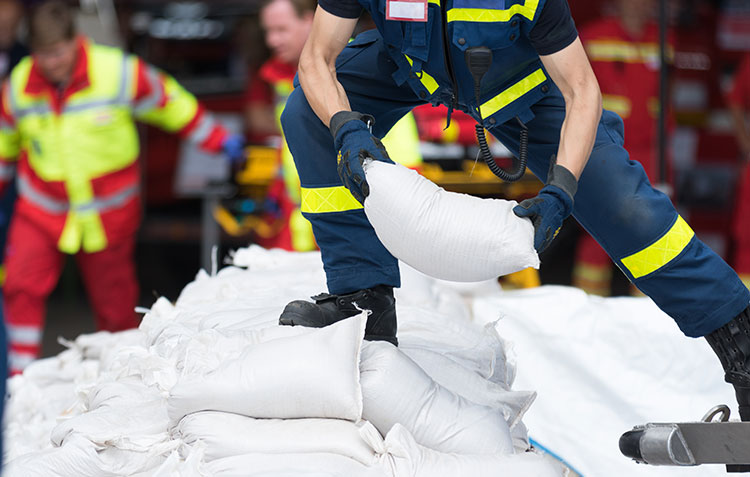Sandbag dikes are the most common but temporary method used to protect property from flood damage and have been used in this manner for some 150 years. Sand is a common yet relatively cheap material and is readily available to most communities. A properly constructed sandbag dike can be effective, but sandbag dikes can fail. Here’s why!
Improper Construction
Width to height ratio incorrect: the USACE (US Army corps of Engineers) recommends a ratio of 10:4 but this may be old data; the most common ratio is 3:1, i.e., for every 1 foot of height, 3 ft of width is needed.
Different websites indicate different numbers of sandbags required for every foot of height per every foot of length, but more on this later.
Failure to dig a “bonding” trench (and fill it with sandbags) to be located underneath the sandbag wall. The bonding trench should be used for dikes of 3 feet in height or greater. Build dikes 4-6 inches deep and 18-24 inches wide. Strip the sod before laying the trench.
Failure to properly lay each bag, untied with the open ends tucked underneath the bag, in the direction of the water flow.
Failure to properly fill each sandbag-no more than 25-35 pounds of sand generally, about ½ full (USACE says 2/3 full). Too full and the bags may not lay properly, creating gaps through which water may flow through. Could be as much as 4 pounds depending on the size of the bag.
Failure to cover the entire barrier with plastic sheathing (6 mils recommended), and/or to secure it to the barrier to prevent wind or wave action from removing the sheathing. The sheathing is used to keep water from penetrating between the bags, culminating in water flow behind the
barrier.
Building walls at 90-degree right angles (to the flow of water) will, with impact with the water, cause the barrier to collapse.
Insufficient Barrier Height
Underestimating the height of the barrier. The government will issue data in respect of the anticipated height of the flood, and you may build to that height, but strong winds can whip up waves which over-top the barrier. The accumulation of water behind the barrier (and in front) may cause the barrier to fail, or even if it still holds, continuous-wave action could result in overtopping resulting in property damage. Sandbag barriers should have at least 2 feet of “freeboard”. i.e., the height of the barrier should be 2 feet above the estimated maximum height of the water.
Sand Boils, Gopher Holes, and Porous Ground
Any of these can cause water to flow underground, essentially bypassing the barrier, rising to the surface, and flooding the “protected area”.
There are other problems associated with sandbag dikes.
It should be noted that most government agencies offering advice on sandbag dikes suggest that these dikes, when properly constructed, should range from 3-5 feet in height. Beyond 5 feet some degree of instability begins to set in.
Ambient Conditions, such as frozen ground and freezing weather-frozen ground may deter people from digging the required trench and cold weather could result in ice formation where moisture collects between the sandbags which can cause shifting. Freezing weather may also result in ice formation along the bottom of the barrier, and this could cause the barrier to shift or slide resulting in catastrophic barrier failure.
There are other issues in dealing with sandbags.
River and lake water is dirty. The fact that you may swim in it doesn’t change the fact that such waters are filled with bacteria. And if raw sewage gets into them – well, that just proves my point even further. As a result, the sand is not clean so don’t use it for your child’s sandbox. The sand must be hauled away and the cost of any heavy-duty equipment such as a loader and a dump truck used to haul the sand away to the nearest dump is a cost usually borne by the property owner.
As mentioned above, different websites showing the construction of sandbag dikes vary in construction methods; one site says to place every sandbag in every 2nd layer at a right angle to the one below it. Other sites don’t say that!
The sheer volume of sand required to build a dike-for 100 ft. length:
Height – FEMA# of bags – USACE # of bags
1 ft – 600 – 600
2 ft – 1,700 – 2,100
3 ft – 3,000 – 4,500
4 ft – 5,500 – 7,800
5 ft – 9,000 – n/a
With each bag of sand weighing, say 30 pounds, a 4 ft high sand barrier would require 234,000 pounds of sand (USACE), i.e., 117 tons.
Sources:
- “Sandbagging Techniques” and “Flood Fight Handbook” US Army Corps of engineers Government of BC.
- North Dakota State University; “Build Sandbag Dikes the Right Way”.
- Government of Manitoba, Emergency Measures Organization.


